
A glacier is a persistent body of dense ice that is constantly moving under its own weight. A glacier forms where the accumulation of snow exceeds its ablation over many years, often centuries. It acquires distinguishing features, such as crevasses and seracs, as it slowly flows and deforms under stresses induced by its weight. As it moves, it abrades rock and debris from its substrate to create landforms such as cirques, moraines, or fjords. Although a glacier may flow into a body of water, it forms only on land and is distinct from the much thinner sea ice and lake ice that form on the surface of bodies of water.
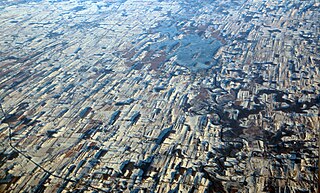
A drumlin, from the Irish word droimnín, first recorded in 1833, in the classical sense is an elongated hill in the shape of an inverted spoon or half-buried egg formed by glacial ice acting on underlying unconsolidated till or ground moraine. Assemblages of drumlins are referred to as fields or swarms; they can create a landscape which is often described as having a 'basket of eggs topography'.

A moraine is any accumulation of unconsolidated debris, sometimes referred to as glacial till, that occurs in both currently and formerly glaciated regions, and that has been previously carried along by a glacier or ice sheet. It may consist of partly rounded particles ranging in size from boulders down to gravel and sand, in a groundmass of finely-divided clayey material sometimes called glacial flour. Lateral moraines are those formed at the side of the ice flow, and terminal moraines were formed at the foot, marking the maximum advance of the glacier. Other types of moraine include ground moraines and medial moraines.

Till or glacial till is unsorted glacial sediment.
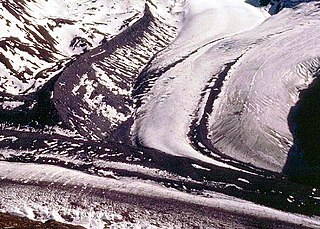
Glaciology is the scientific study of glaciers, or, more generally, ice and natural phenomena that involve ice.

A ridge is a long, narrow, elevated geomorphologic landform, structural feature, or a combination of both separated from the surrounding terrain by steep sides. The sides of a ridge slope away from a narrow top, the crest or ridgecrest, with the terrain dropping down on either side. The crest, if narrow, is also called a ridgeline. Limitations on the dimensions of a ridge are lacking. Its height above the surrounding terrain can vary from less than a meter to hundreds of meters. A ridge can be either depositional, erosional, tectonic, or a combination of these in origin and can consist of either bedrock, loose sediment, lava, or ice depending on its origin. A ridge can occur as either an isolated, independent feature or part of a larger geomorphological and/or structural feature. Frequently, a ridge can be further subdivided into smaller geomorphic or structural elements.

The climatic snow line is the boundary between a snow-covered and snow-free surface. The actual snow line may adjust seasonally, and be either significantly higher in elevation, or lower. The permanent snow line is the level above which snow will lie all year.

The Byrd Polar and Climate Research Center (BPCRC) is a polar, alpine, and climate research center at The Ohio State University founded in 1960.

A subglacial lake is a lake that is found under a glacier, typically beneath an ice cap or ice sheet. Subglacial lakes form at the boundary between ice and the underlying bedrock, where gravitational pressure decreases the pressure melting point of ice. Over time, the overlying ice gradually melts at a rate of a few millimeters per year. Meltwater flows from regions of high to low hydraulic pressure under the ice and pools, creating a body of liquid water that can be isolated from the external environment for millions of years.
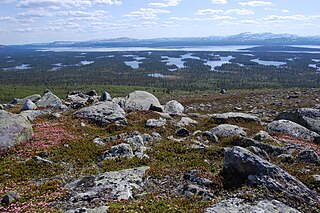
A Rogen moraine is a subglacially formed type of moraine landform, that mainly occurs in Fennoscandia, Scotland, Ireland and Canada. It is one of the three main types of hummocky moraines. They cover large areas that have been covered by ice, and occur mostly in what is believed to have been the central areas of the ice sheets. Rogen moraines are named after Lake Rogen in Härjedalen, Sweden, the landform's type locality. Rogen Nature Reserve serves to protect the unusual area.
Radioglaciology is the study of glaciers, ice sheets, ice caps and icy moons using ice penetrating radar. It employs a geophysical method similar to ground-penetrating radar and typically operates at frequencies in the MF, HF, VHF and UHF portions of the radio spectrum. This technique is also commonly referred to as "Ice Penetrating Radar (IPR)" or "Radio Echo Sounding (RES)".

The geology of Iceland is unique and of particular interest to geologists. Iceland lies on the divergent boundary between the Eurasian plate and the North American plate. It also lies above a hotspot, the Iceland plume. The plume is believed to have caused the formation of Iceland itself, the island first appearing over the ocean surface about 16 to 18 million years ago. The result is an island characterized by repeated volcanism and geothermal phenomena such as geysers.
Fluvioglacial landforms or glaciofluvial landforms are those that result from the associated erosion and deposition of sediments caused by glacial meltwater. Glaciers contain suspended sediment loads, much of which is initially picked up from the underlying landmass. Landforms are shaped by glacial erosion through processes such as glacial quarrying, abrasion, and meltwater. Glacial meltwater contributes to the erosion of bedrock through both mechanical and chemical processes. Fluvio-glacial processes can occur on the surface and within the glacier. The deposits that happen within the glacier are revealed after the entire glacier melts or partially retreats. Fluvio-glacial landforms and erosional surfaces include: outwash plains, kames, kame terraces, kettle holes, eskers, varves, and proglacial lakes.

Kirk Martinez is a Professor in Electronics and Computer Science at the University of Southampton UK. He gained a BSc in Physics from the University of Reading and a PhD in Image Processing in the department of Electronic Systems Engineering at the University of Essex. While Arts Computing Lecturer at Birkbeck College London (1987–96) he pioneered the digital imaging of paintings together with The National Gallery, London in the European project VASARI (1980s). This led to development of art imaging projects to print accurate art books, view high detail images on the web and find art images online. He has published this research in books on image processing and computer architecture as well as Transactions of the IEEE on content-based image retrieval He was an advisor on the imaging and image processing required for the Archimedes Palimpsest. Recent research led to a new imaging system for ancient seals together with Oxford University - which is helping to capture and read historic texts.
In the earth sciences, the terms fluting and flute have very different meanings in its subdisciplines of geomorphology, glaciology, sedimentology, and speleology.
Glacial flutes, also known as glacial fluting, are low, narrow, elongate, straight, parallel ridges that range between several centimeters to a few meters both in width and height. This glacial landform generally consist of glacial till, but sometimes either sand or silt and clay. They form subglacially and are orientated parallel to the direction of glacier flow. They occur in parallel sets of ridges known as swarms. Because of their narrow width and low height, they are often hard to identify during ground or bottom surveys. As a result, they have to be mapped by high-resolution satellite data or LiDAR techniques on land and by high-resolution side-scan sonar at sea.
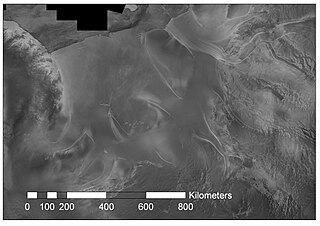
Rutford Ice Stream is a major Antarctic ice stream, about 290 kilometres (180 mi) long and over 24 kilometres (15 mi) wide, which drains southeastward between the Sentinel Range, Ellsworth Mountains and Fletcher Ice Rise into the southwest part of Ronne Ice Shelf. Named by US-ACAN for geologist Robert Hoxie Rutford, a member of several USARP expeditions to Antarctica; leader of the University of Minnesota Ellsworth Mountains Party, 1963-1964. Rutford served as Director of the Division of Polar Programs, National Science Foundation, 1975-1977.
Subglacial streams are conduits of glacial meltwater that flow at the base of glaciers and ice caps. Meltwater from the glacial surface travels downward throughout the glacier, forming an englacial drainage system consisting of a network of passages that eventually reach the bedrock below, where they form subglacial streams. Subglacial streams form a system of tunnels and interlinked cavities and conduits, with water flowing under extreme pressures from the ice above; as a result, flow direction is determined by the pressure gradient from the ice and the topography of the bed rather than gravity. Subglacial streams form a dynamic system that is responsive to changing conditions, and the system can change significantly in response to seasonal variation in meltwater and temperature. Water from subglacial streams is routed towards the glacial terminus, where it exits the glacier. Discharge from subglacial streams can have a significant impact on local, and in some cases global, environmental and geological conditions. Sediments, nutrients, and organic matter contained in the meltwater can all influence downstream and marine conditions. Climate change may have a significant impact on subglacial stream systems, increasing the volume of meltwater entering subglacial drainage systems and influencing their hydrology.
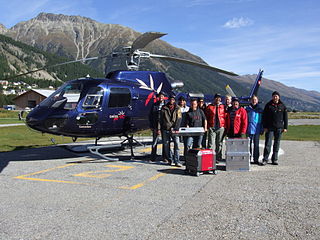
IceMole is an autonomous ice research probe, incorporating a new type of ice-melting tip for the exploration of polar regions, glaciers, ice sheets, and extraterrestrial regions, developed by a team from the FH Aachen, a Fachhochschule in Aachen, Germany. The advantage over previous probes is that the IceMole can change its direction and can be recovered after being used. A driving ice screw allows the probe to drill through soil layers and other contaminations in the ice.
Enceladus Explorer (EnEx) is a planned interplanetary orbiter and lander mission equipped with a subsurface maneuverable ice melting probe suitable to assess the existence of life on Saturn's moon Enceladus.












